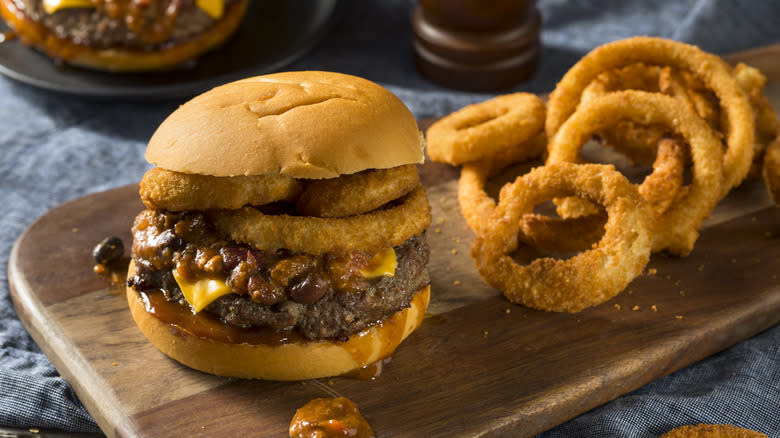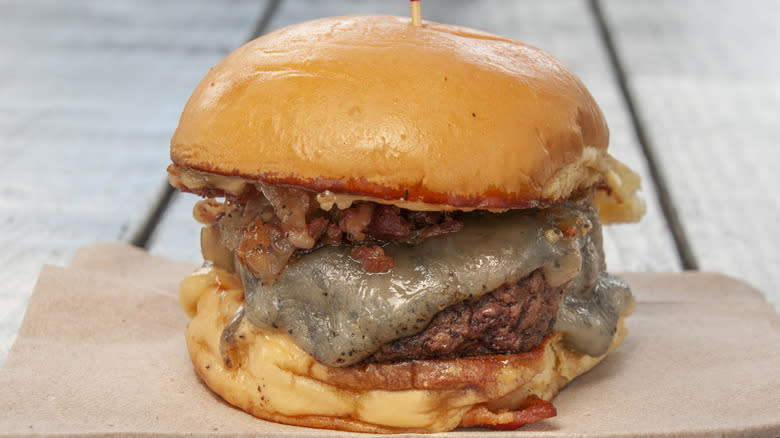What Are The Origins Of The Iconic Chili Burger?

For those who prefer their burgers extra saucy and extra spicy, ketchup and mustard just won't do. That's where the chili burger and all its glory comes into play. In many iterations, the sandwich features a beef patty, chili, cheese, and onions. Fans can thank the city of Los Angeles for its invention, having been created around a century ago.
Many believe that restaurant owner Thomas M. DeForest was the original inventor of the sandwich in the 1920s. DeForest sold the burger at his restaurant Ptomaine Tommy's. Reportedly, he had two different ladle sizes to sell the chili -- one for the burgers and one for a bowl of chili. Over time, it became referred to as just size and oversize, which became a popular term in the surrounding L.A. community. Likewise, onions were referred to as flowers at the restaurant.
Typically served open-face, DeForest's burger became a hit with the general public. The restaurant owner was even recognized by the California State Senate for its contribution to the state's cuisine. Ptomaine Tommy's attracted customers from all walks of life, which contributed to the chili burger's popularity spreading. While Ptomaine Tommy's may have been its first home, it wouldn't be its last.
Read more: The Ultimate American Fast Food Restaurants Ranked
Chili Burgers Become A California Staple

Unfortunately for Tommy DeForest, despite the relative popularity of his chili burgers, he ended up selling the restaurant due to mounting debt. He would pass away only a week later after the sale. The chili burger would find a new home thanks to another restauranteur named Tom. In 1946, several years before DeForest closed his doors, Tom Koulax launched Original Tommy's World Famous Hamburgers and began selling chili burgers.
Koulax originally sold his burgers out of a food stand. Despite the name, Koulax may not have been the original Tommy in the chili burger business, but his restaurant would have the staying power that DeForest lacked. Today, there are 32 locations for Original Tommy's, mostly situated in the West in California and Los Angeles. The restaurant separates itself thanks to a limited menu as well as a grassroots marketing campaign, with word of mouth being the main means of advertising.
Original Tommy's isn't the only place you might find a chili burger. Over the years, there have been several contenders for the chili burger throne. The sandwich has become part of the Californian cuisine, with many restaurants offering their takes. However, the burger has also expanded beyond California as well.
A Southern Variant

The exact link between the Carolina burger and the California chili burger isn't clear. It's possible that visitors from California brought the idea to the Carolinas. It's also possible that the two ideas developed independently. As either would be speculation, it's best not to ponder too much. However, it's easy to see the Carolina burger as a variant of the traditional chili burger with some tweaking. The Carolina burger features a combination of both chili as well as coleslaw. Some recipes call for both mustard and onions as well. It's believed that the recipe may have originated somewhere in Piedmont, North Carolina, but no one knows who developed the concept first.
Unlike the chili burger, the Carolina-style burger typically features Southern-style chili that's more meaty with fewer beans. This also makes it stand out in comparison to its Western cousin. The burger reached new audiences when the restaurant chain Wendy's ran a limited-time promotion of the burger in North Carolina and South Carolina. Whether you're eating the Carolina-style burger or the original California recipe, chili can give your sandwich new dimensions and flavors. The combo makes for a hearty, fulfilling meal, so it's no wonder it's stood the test of time.
Read the original article on Daily Meal.

